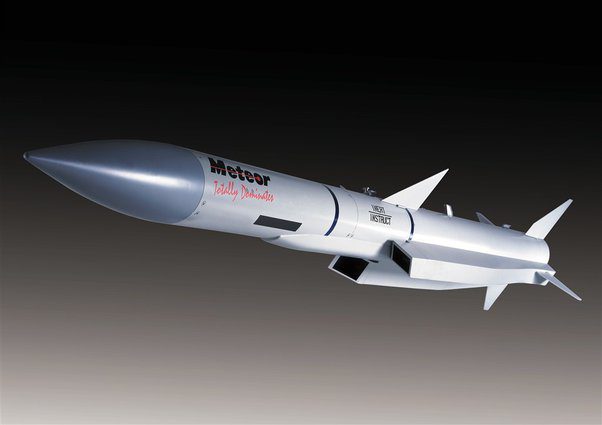Note: This article discusses the specifications of MBDA Meteor & Aim-120 AMRAAM Beyond Visual Range Missiles(BVRM) in detail.
Beyond visual range missiles are as important for air combat, as the aircraft itself. Their integration together brings jaws of steel in the war, especially against 5th generation below aircrafts. With the arrival of Meteor in south Asia (India), where no 5th generation aircraft is operational to date, it poses a significant threat to adversaries (Pakistan & China). In this context, it is important to compare it with its counterparts. Meteor vs PL-15 comparison has already been done, and available on this website. But, since J-10Cs aren’t operational in PAF yet, it’s important to compare Meteor with Aim-120C5 AMRAAM available with PAF’s Falcons, Block 15-52s.
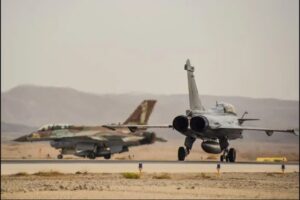
General Characteristics
MBDA Meteor
- Mass: 190 Kg
- Length: 3.65 m
- Diameter: 178 mm
- Warhead: HE Blast Fragmentation
- Range: ~150 Kms
- No Escape Zone: 60 Kms
AIM-120 AMRAAM
- Mass: 152 Kg
- Length: 3.7 m
- Diameter: 180 mm
- Warhead: HE Blast Fragmentation
- Range: 100+ Kms
- No Escape Zone: 35 Kms
Aim-120 is lighter with approximately equal dimensions as those of Meteor, which means that an aircraft can carry more Aim-120s with equal amount of drag being produced if less Meteors would have been placed, while Meteor has a longer range with better fuel efficiency and constant speed.
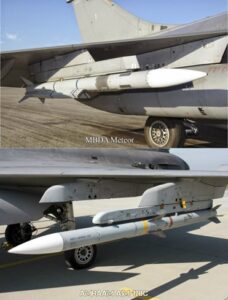
Guidance System
Both missiles have 2-way data link, which enables them to notify the mother ship about the fuel, velocity and propulsion parameters, mid-course guidance and terminal phase target locking notification can be sent as they both house AESA Seekers. They have Home on Jamming capabilities as well, in which the missiles switches from active radar homing to passive radar homing and chase the radiation source when jamming is applied by the target aircraft. Both Fox-3 missiles are fire & forget in their terminal phase, after that the mothership can break the radar lock and roll away from the cranking of radar’s azimuth coverage.
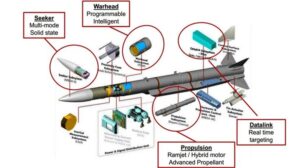
Propulsion
MBDA Meteor has a two-stage propulsion mechanism, first being the solid fuel rocket motor, which ignites and kindle its life to provide a high supersonic speed to the missile, post which the Solid Fuel Ducted Ramjet Engine ignites. In the first phase of propulsion (Boost Phase), the air intakes and port cover to the gas chamber remain sealed and opens only after the ramjet engine starts burning. The ignition to the ram engine is provided by the rocket motor itself. Meteor has a throttleable propulsion system that helps it in maintaining a constant speed throughout its flightpath until the fuel is burnt completely.
This feature provides it a speed of Mach 4, the throat area to the gas chamber is inversely related to the fuel ignition. Air from the intakes is compressed and its speed is reduced, it is then introduced into the gas chamber where solid fuel has formed a gaseous fluid having no oxygen to burn. As the mix up, auto ignition takes place and gases are exhausted from the nozzle less exhaust chamber. It is first of its kind in BVR air-air missiles category and being a continuously propelled missiles, it retains its energy for at least 100 Kms, and beyond that it behaves like a guided artillery shell, trading off its altitude with kinetic energy. Being said that Meteor has yet to face any adversary in a real war scenario, where its capabilities will be tested.
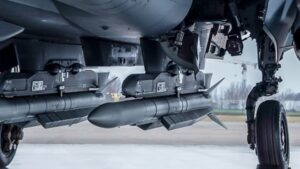
Aim-120 is powered by a single-phase solid fuel rocket motor with inhouse fuel and oxidizer, which once ignites and keep burning till its life, providing a high kinetic energy to the missiles, which then depletes as the missile moves ahead. Once burnt, the missile behaves as an artillery projectile, and the control system guides it to its target. This conventional method is battle proven and has scored kills against very agile and high-speed targets e.g., Mig-21, Su-30 MKI etc. The C5 variant of Aim-120 has a no escape zone of 35 Kms, and effective range of 80-90 Kms. It is lower than that of Meteor, but everything comes at a cost.
Aim-120’s range can vary depending upon the altitude, as air density decreases and consequently air drag decreases as we go up, but high altitude is not favorable for Meteor. Its booster may ignite and provide it with a Mach 2-3 speed, but lack of enough oxygen may hinder its engine performance and it may dispose of when being unable to retain high supersonic speed, as ramjet can’t work below it.For instance, fighter jets e.g., F-16 can fly up to 50,000 feet of altitude, while the oxygen percentage in air at 1000 feet is 20.1%, while it decreases to 6.3% at 30,000 feet. Meteor has no compressor element involved in it other than the air intakes and static channels, thus the performance decreases as the altitude increases.
It can be concluded that Meteor is a superior missile in its propulsion system but is limited to its latitude, while Aim-120 if fired from a high altitude towards a target at lower altitude, will be lethal as it will have additional potential energy and due to thin air, will have additional kinetic energy available.
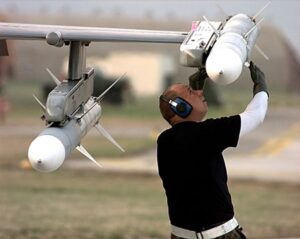
Better versions of Aim-120 are available now named as C7 and D, having effective ranges double to that of C5s and competes with the range of Meteor with conventional power sources, yet Meteor retains the edge to being a constant high-speed missile with high kinetic energy in most of its flight path and fuel efficient as well. But the altitude will be a game changing element when they are pitched against each other’s from a 4th or 4.5th generation aircrafts. 5th generation aircrafts cannot be discussed simply in this comparison as they have their own advantages in addition to their missiles.
#StingRay
#Horus
#TeamPakistanStrategicForum



